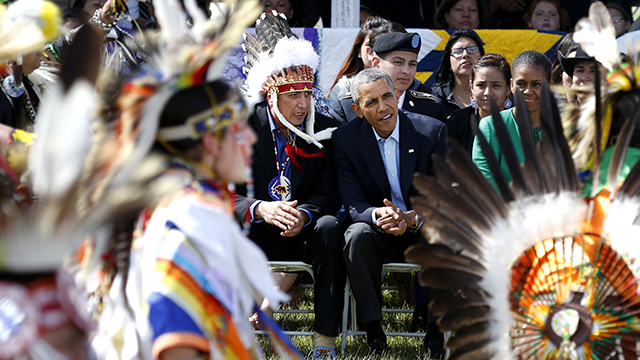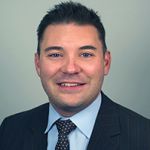This post first appeared at TalkPoverty.

In June 13, 2014 President Obama made his first visit to an Indian Country at the Standing Rock Indian Reservation. (AP Photo/Charles Rex Arbogast)
Earlier in my career, I worked in the tribal criminal justice system on reservations in the Southwest. Tribal courts were often ground zero for seeing the day-to-day challenges facing American Indian and Alaska Native (AIAN) youth as well as the consequences of failed policies and underinvestment in their communities.
I remember, for example, young people who bootlegged alcohol from local towns off the rez — at a profit for non-Native business owners — and then were caught selling it to friends from school who struggled with substance abuse. Good-hearted tribal court judges tried to help them understand the consequences of repeated offenses, only to find that many of these young Native people simply felt they had no real opportunities ahead of them, no real future. This sense of hopelessness among low-income tribal communities across the country — and the actions that many young people take as a result — are the symptoms of a much deeper problem, not the cause of it.
Many in our country feel as if nothing can be done about deep and persistent poverty and accompanying challenges such as substance abuse, especially in low-income places like tribal communities, and particularly on reservations. But AIAN youth who are organizing for change across the country are bringing something unique to the table — a belief that none of these challenges are intractable, and an expectation of older generations to support their efforts to create opportunity. Young people also believe that their tribal culture should play a powerful role in any reform efforts and in their future.
That is why President Obama’s new commitment matters — a lot. Last month, he announced a new agenda focusing on Native youth at the annual White House Tribal Nations conference. The agenda includes listening tours by cabinet secretaries in Indian Country; reorganizing and strengthening some education programs serving AIAN youth; a new national leadership network called “Generation Indigenous”, in partnership with the Center for Native American Youth at the Aspen Institute; and the first White House tribal youth conference in 2015.
In the President’s address to hundreds of tribal leaders at the conference, he highlighted his recent trip to the Standing Rock Sioux Tribe where he met with a group of tribal youth:
And the truth is those young people were representative of young people in every tribe, in every reservation in America. And too many face the same struggles that those Lakota teenagers face. They’re not sure that this country has a place for them. Every single one of them deserves better than they’re getting right now. They are our children, and they deserve the chance to achieve their dreams. So when Michelle and I got back to the White House after our visit to Standing Rock, I told my staff … I brought whoever [in my cabinet was] involved in youth and education and opportunity and job training, and I said, you will find new avenues of opportunity for our Native youth. You will make sure that this happens on my watch. And as I spoke, they knew I was serious because it’s not very often where I tear up in the Oval Office. I deal with a lot of bad stuff in this job. It is not very often where I get choked up….
For those of us who work with AIAN youth it comes as little surprise that the President would “get choked up.” These young people struggle with some of the most severe challenges in the country: 37 percent of AIAN children under 18 live in poverty, significantly higher than the national child poverty rate of 22 percent (according to the American Community Survey). The AIAN graduation rate is the lowest of any racial and ethnic group at 68 percent. For students served by the Bureau of Indian Education, the graduation rate is only 53 percent, compared to the national graduation rate of 80 percent. One recent study showed 18.3 percent of AIAN 8th graders reported binge drinking, compared to 7.1 percent nationally. Perhaps most stunning, suicide is the second leading cause of death for AIAN youth between ages 15 and 24 — they commit suicide at 2.5 times the national rate.
It’s far past time that we offer real and significant support to AIAN youth, and the President’s initiative is a good start. It puts the voices and goals of AIAN youth front and center, building off of an agenda that has been growing among youth in tribal communities across the country for years. If done well, this initiative will lift up the great work already being undertaken by AIAN youth and provide some of the tools they need to achieve real change in their communities.
Each year, the Center for Native American Youth — a partner on the new Generation Indigenous network — publishes the Voices of Native Youth report. Its staff members travel to tribal communities across the country to conduct roundtables with AIAN youth and identify challenges, priorities and promising solutions to address the many obstacles that they face. In the most recent report, AIAN youth identified significant and much needed changes in education, health and wellness, and bullying and school discipline, among other areas. They also made it clear that preserving and strengthening their culture and language must be at the center of any agenda.
The President took a significant step towards empowering the AIAN youth movement to make these and other reforms in their communities. Elizabeth Burns — a Center for Native American Youth “2014 Champion for Change” and a member of the Cherokee Nation of Oklahoma — is an example of why this kind of leadership is important for a movement that has been so marginalized. She said: “I have been told that my dream of helping other Native youth is ridiculous and that I should give up. I realized that negative comments won’t hold me back. I will make my dream a reality.”
It’s time for the rest of us to stand behind the President and youth like Elizabeth. To learn more about the Champions for Change and AIAN youth agenda visit the Center for Native American Youth.
The views expressed in this post are the author’s alone, and presented here to offer a variety of perspectives to our readers.


